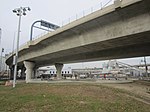Charles River Bridge (Commuter Rail)
Bascule bridges in the United StatesBridges in Middlesex County, MassachusettsBridges over the Charles RiverBuildings and structures in Cambridge, MassachusettsHistoric American Engineering Record in Massachusetts ... and 10 more
MBTA Commuter RailMassachusetts Bay Transportation Authority stubsMassachusetts building and structure stubsMassachusetts transportation stubsNortheastern United States bridge (structure) stubsRailroad bridges in MassachusettsSteel bridges in the United StatesTransportation in Cambridge, MassachusettsTruss bridges in the United StatesUnited States railway bridge stubs

The Charles River Bridge is a pair of railroad single-leaf, through-truss, rolling bascule bridges across the Charles River that connects North Station in Boston, Massachusetts to MBTA Commuter Rail lines in northern Massachusetts, United States.
Excerpt from the Wikipedia article Charles River Bridge (Commuter Rail) (License: CC BY-SA 3.0, Authors, Images).Charles River Bridge (Commuter Rail)
Community Path, Cambridge West End
Geographical coordinates (GPS) Address External links Nearby Places Show on map
Geographical coordinates (GPS)
| Latitude | Longitude |
|---|---|
| N 42.36898 ° | E -71.06529 ° |
Address
Charles River Bridge
Community Path
02214 Cambridge, West End
Massachusetts, United States
Open on Google Maps










